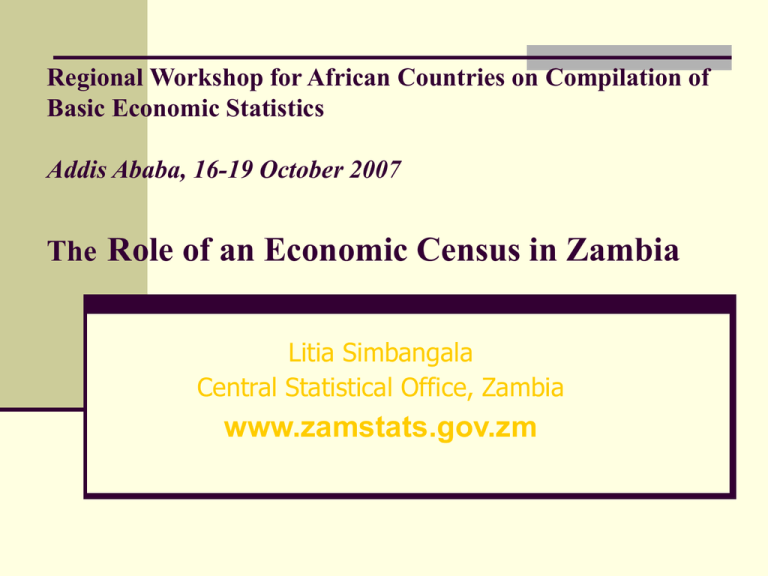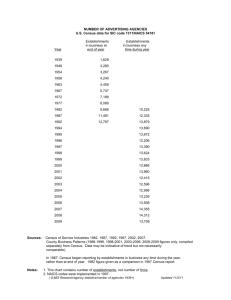Role of an Economic Census in Zambia The www.zamstats.gov.zm
advertisement

Regional Workshop for African Countries on Compilation of Basic Economic Statistics Addis Ababa, 16-19 October 2007 The Role of an Economic Census in Zambia Litia Simbangala Central Statistical Office, Zambia www.zamstats.gov.zm What is an Economic Census? An Economic Census is the full measurement of the state of the economy It is the total process of collecting, compiling, evaluating, analysing and publishing economic data pertaining, at a specific time or times, from all business and social establishments in a designated area or country It is the primary source of information about business activities in an economy It ultimately forms a basis for all economic surveys in an economy Background In the early 1990’s, Zambia embarked on a vigorous restructuring exercise of its economy that brought about structural changes in almost all the sectors of the economy. The restructuring exercise included: Privatisation of previously government run/owned companies Liberalisation of both domestic and foreign trade Liberalisation of the foreign exchange market Restructuring of the Health, Education and other sectors Basically promoting the private sector as the engine for economic growth Rationale I In order to measure the impact of the changes in the economy, there is need for a set of macro-economic indicators that are produced regularly and on a timely basis and using the most recent internationally accepted methodologies and classification systems. Additionally the Office is faced with the constraints outlined below: Lack of up-to-date benchmark data Lack of comprehensive indicators for the Gross Domestic Product (GDP) compilation New revised methodologies such as the 1993 System of National Accounts (SNA) and revised classification systems (e.g. ISIC rev. 4) have not been fully adopted due to lack of comprehensive data To measure the full value added (GDP) of the Zambian economy To provide a comprehensive frame of establishments for all economic surveys, which will be updated from time to time To provide data which will enable the CSO compile a full set of national accounts (input-output tables, Gross Fixed Capital formation, Investment, etc) Objectives To measure the full value added (GDP) of the Zambian economy To provide a comprehensive frame of establishments for all economic surveys, which will be updated from time to time To provide data which will enable the CSO compile a full set of national accounts (input-output tables, Gross Fixed Capital formation, Investment, etc) To measure the true extent of investment in Zambia; both foreign and domestic To provide a basis for setting up comprehensive Balance of Payments statistics To provide a basis for the production and rebasing of different kinds of Economic Statistics (Producer Price Index, Index of Industrial Production, etc.) Start up activities Pre-test was carried out in March 2007 Targeted 3 Districts Pilot survey was conducted in May & June 2007 Covered 18 Districts Data was analyzed in July Study tours to the USA, Egypt and India Methodology The Economic Census is being carried out in two phases Listing of all establishments in Zambia Enumeration of the listed establishments Coverage I All establishments domiciled in Zambia in all the 72 districts will be covered Formal or informal Large scale, medium scale, small scale or micro businesses An establishment is any entity where a good or service is produced or provided Coverage II All industrial sectors as classified in ISIC rev. 4 will be covered Exception: Subsistence agriculture These include: Established agriculture Forestry & fisheries Mining and quarrying Manufacturing Electricity and water supply Construction Trade Hotels, bars and restaurants Transport, storage and communication Financial intermediation and insurance (bank and non-bank) Real estate, business services Education, health, personal services, etc. Coverage III CSO has mapped Zambia into enumeration areas within administrative boundaries (provinces, districts, constituencies and wards) At the last mapping exercise (for the 2000 Population Census) 16, 800 EAs were generated All the 16, 800 EAs will be covered during the Economic census Survey Questionnaires The listing phase consists of three types of questionnaires: The household business activity roster The household establishments listing book The Listing of Establishments book During the enumeration phase each industry will have its on type of questionnaires: Household Business Activity Roster The household business activity roster targets the following: Establishments that operate within the household premises Establishments that operate outside the household premises Not in fixed locations and not in any structure such as mobile traders, hawkers, pirate taxis, etc Landlords Household establishments listing book This questionnaire will be used to list all the establishments identified in the Household Business Activity Roster Listing of Establishments Book Targets the following: Establishments that can be clearly identified i.e. those that are either in a fixed location but not in a structure, or those in fixed structures and not within the household premises These establishments include stone crashers, tuntemba, grocery shops, carpentry shops, banks, schools, hospitals, offices (government ministries and their departments, non-governmental organisations etc), and churches and so on The following data sets will be the outputs from the Economic Census Provincial, quarterly and total GDP Re-based National Accounts Full set of National Accounts Level of investment Total Balance of Payments (BOP) Revised weights for the Index of Industrial Production (IIP) Revised weights for the Producer Price Index (PPI) Input-Output Tables Social Accounting Matrix Comprehensive register of establishments Periodicity The CSO is undertaking an Economic Census for the first time It intends to be conducting these censuses every five (5) years End of Presentation Thank you for your attention


